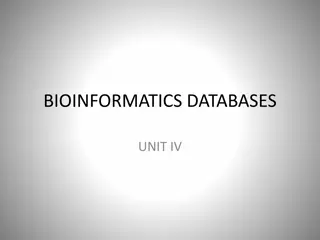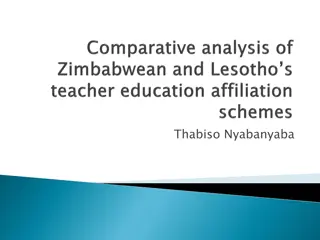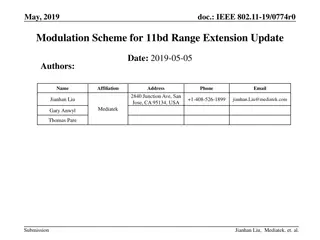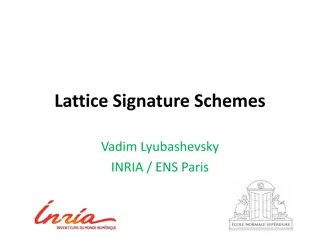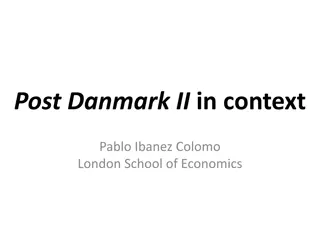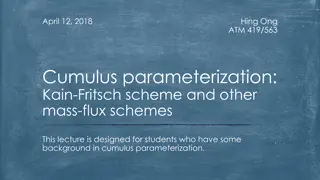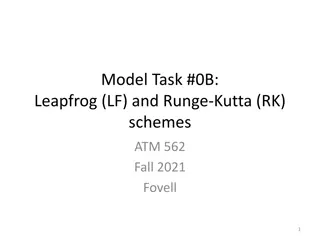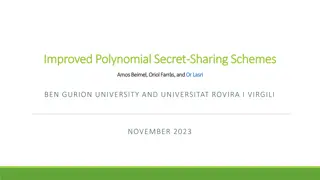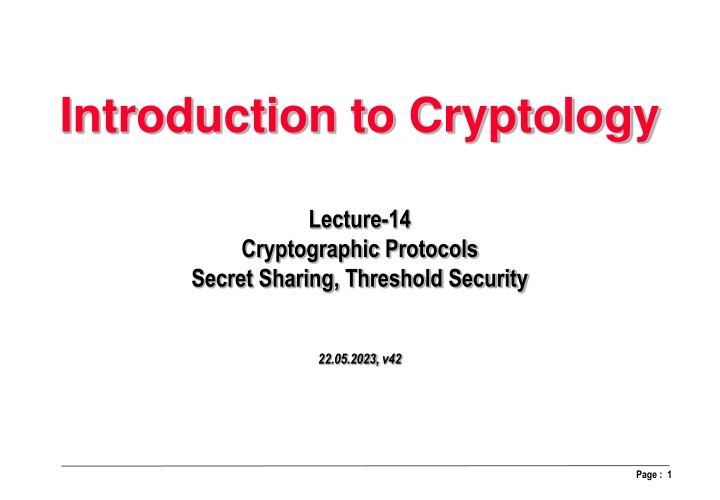
Cryptographic Protocols and Secret Sharing in Cryptology
Learn about cryptographic protocols like Shamir 3-Pass Protocol, secret sharing techniques, and threshold security schemes in the field of cryptology. Explore concepts such as no-key security protocols, Shamir's Threshold Scheme, and the use of encryption techniques like Vernam One-Time Pad Lock and Matrix Product Lock.
Download Presentation

Please find below an Image/Link to download the presentation.
The content on the website is provided AS IS for your information and personal use only. It may not be sold, licensed, or shared on other websites without obtaining consent from the author. If you encounter any issues during the download, it is possible that the publisher has removed the file from their server.
You are allowed to download the files provided on this website for personal or commercial use, subject to the condition that they are used lawfully. All files are the property of their respective owners.
The content on the website is provided AS IS for your information and personal use only. It may not be sold, licensed, or shared on other websites without obtaining consent from the author.
E N D
Presentation Transcript
Introduction to Cryptology Lecture-14 Cryptographic Protocols Secret Sharing, Threshold Security 22.05.2023, v42 Page : 1
Outlines No key Security protocols Shamir 3-Pass Protocol - Omura-Massey Lock over GF(p) - Massey Omura Lock over GF(2m) Secret Sharing Protocols - Non-Perfect Secret Sharing - Perfect Secret Sharing Threshold Schems - Shamir s Threshold Scheme Page : 2
No-Key Secrecy Protocols Secrecy procedure require - No secret agreement - No open keys at all Page : 3
Cryptographic Protocols No Key Cryptography : Shamir s 3-Pass Protocol (Mechanical scenario/simulation) User A User B Pass 1 B A Pass 2 Pass 3 A Page : 4
Vernam One-Time-Pad Lock for: Shamir s 3-Pass Protocol User A User B Vernam Cipher ZA ZB 1 Y1= M + ZA = M Y2= Y1+ ZB 2 Y2= M + ZA + ZB ZA+ Y2 = Y3 Y3= M + ZB 3 Remove Key ZA M= Y3+ ZB Attack: Y1+ Y2+ Y3= M Page : 5
Simple Product Cipher Lock for: Shamir s 3-Pass Protocol User A User B Multiplication Cipher ZA ZB 1 Y1= M * ZA = M Y2 = Y1* ZB 2 Y2= M * ZA * ZB Y3=Y2* ZA-1 3 Y3= M * ZB M= Y3* ZB-1 Attack: Y2 / Y1= ZB then M = Y3* ZB-1 Page : 6
Matrix Product Lock for: Shamir s 3-Pass Protocol User A User B Product Cipher ZA ZB 1 Y1= [M] * [ZA] = M 2 Y2= [ZB]* [M] * [ZA] Y3= Y2[ZA]-1 3 Y3= [ZB] * [M] M= [ZB]-1* Y3 Attack: Y2 / Y1= ZB then M = [ZB]-1* Y3 Page : 7
Omura-Massey Lock* over GF(p) for: Shamir s 3-Pass Protocol Secrecy without Authenticity User A User B p = large prime, arithmetic in GF(p) [ modulus in the exponent is (p-1) ] Eb= secret key Db= Eb-1(mod p-1) gcd (Eb, p -1) = 1 Ea= secret key Da= Ea-1(mod p-1) gcd (Ea, p -1) = 1 Eb ( ) 1 Ea Ea M = M M Ea Eb M 2 Da ( ) M Db Ea Eb ( ) 3 Eb Eb M = M M gcd (Ei, p -1) = 1 # of keys = (p-1) * J.L. Massey & J. K. Omura, US Patent, 1986 Page : 8
A secrecy system based on Omura-Massey Lock for: Shamir s 3-Pass Protocol 1. Use the Shamir 3-path protocol to exchange a secret key M = Z ( Z must be a unit to be invertible, gcd (Z, p-1) = 1 D = Z-1) 2. Use another exponentiation to exchange data as follows: User A Z = secret key from 1 D = Z-1 User B Z = secret key from 1 D = Z-1 p = large prime, arithmetic in GF(p) D ( ) = M 1 MZ Z = M M Page : 9
Example : Omura-Massey Lock for Shamir 3-Pass Protocol Using GF(19) and the secret keys for users A and B as 7 and 11 Hiding/locking function: MKeymod 19, arithmetic in GF(19) Prime number Modulus in the exponent =(19 -1)=18 (Euler theorem) e2 = 11 11 x 5 = 1 mod 18 e1 = 7 USER B USER A gcd(18,7)=1 7 x 13 = 1 mod 18 e2 = 11 d2 = e2-1 = 5 e1 = 7 d1 = e1-1 = 13 Y1= (27) = (14) mod 19 Message M = 2 Y2= (27)11 mod 18= 25= 13 Y3= (25)13= 265 mod 18 = 211= 15 155 =(211)5= 2 = M Numbr of possible secret keys is (18) = 18 (1-1/3) (1-1/2) = 6 Page : 10
Massey-Omura Lock over GF(2m) for: Shamir s 3-Pass Protocol Secrecy without Authenticity User B ** User A Arithmetic in GF(2m) Eb= secret key Db= Eb-1 (mod 2m-1) gcd (Eb, 2m-1) = 1 Ea= secret key Da= Ea-1(mod 2m-1) gcd (Ea, 2m-1) = 1 1 = M Ea Eb ( ) M Ea M Ea Eb M 2 Da ( ) M Db Ea Eb ( ) 3 Eb Eb M = M M ** For highest security, (2m-1), need to be a prime, example: (2127-1) is a Mersenne prime # of keys = (2m-1) Page : 11
Example: Massey-Omura Lock for Shamir 3-Pass Protocol Design a Massey omura Lock over GF(23) and exchange the message M=110 1. Select a GF(23) generator/modulus P(x) If P(x)= x3+ x +1 is the modulus then x3+ x +1 = 0, thus x3= x +1. the exponents of x in GF(23) are: x = x x2= x2 x3= x +1 x4= x2+x x5= x3+x2= x + 1 + x2 x6= x3 + x2+ x = x2+1 x7= (x3+x )= 1 3. System setup, transactions and message exchange GF(23) generated by: x3+ x +1 Modulus in the exponent is 23-1=7 USER A 010 100 011 110 111 101 001 USER B e2 = 6 d2 = 6 1 mod 7 = 6 Y1= (M)3= x4.3 mod 7 = x12 mod 7 = x5= (111) e1 = 3 d1 = 3 1 mod 7 = 5 Y2= (x5)6= x30 mod 7 = x2=100 Message M = x4 =110 The modulus in the exponent is 2m-1=23-1=7 M=110=(x4) M3=(x4)3 = x12 = x5 =111 Y3= (x2)5= x10 = x3 = 011 (X3)6=x18=x4 = 110=M 2. Secret Key selection gcd(7,3)=1, => 3 is possible to use gcd(7,6)=1, => 6 is possible to use 4. Numbr of possible secret keys is (7)=(7-1)=6 Which is the number of invertible elements in the exponent! Page : 12
Research Question: We used so far only commutative functions for Shamir 3-Pass protocol! Can anybody find a mathematical function which is equivalent to the following non-commutative mechanical lock simulation (the two locks used are disjoint !)? Non-Commutative No Key Cryptography : Shamir 3-Pass Protocol User A User B Page : 13
Non-Perfect Secret Sharing 1001010100 Original secret Part B Part A 10010 10100 1001010100 10010 10100 To break it, any party needs: a maximum of: 25=32 trials Therefore, not perfect! Original Common secret Page : 14
Shamir Perfect Secret Sharing Example: share the secret 1001010100 between users A and B 1001010100 1110111011 Generate a random from a Binary Symmetric Source (BSS) Orig. Secret + 1110111011 Give to User A 0111101111 Give to User B To break it an party needs: A maximum of 210-1=1023 trials Both A and B have no advantage compared with any other attacker + + Exchange to generate Common secret 1001010100 Orig. Common Secret for A and B 1001010100 Page : 15
General Perfect Secret Sharing Shamir Random Source Random Stream Generator Orig. Secret RAND Z + Give User A RAND Give User B Vernam Cipher RAND + Z + + Exchange to generate Common secret Common Orig. Secret Between A and B Z Z Page : 16
Threshold Security t out of n users should present their keys to enable the system K1 K2 K3 Example: two keys should be availabe to open the lock Page : 17
(t,n) Threshold Scheme A cryptographic (t,n) secret-sharing threshold scheme Principle: A secret K is divided into n mapped shares s1 sn(n -> ) in such a way that the knowledge of: any t or more sipieces makes K easily computable any t-1 or less sishares leaves K completely undetermined. Page : 18
Shamirs Threshold Scheme Basic idea* : Shamir s t out of n Threshold Scheme is based on the fact that a polynomial y = f(x) of degree (t-1) can only be uniquely defined by at least t points (xi, yi) with distinct xi. This means that if we have n users each knows only one point on f(x), then any group of at least t users can cooperate to generate the polynomial f(x) as a common secret. In other words: If less that t users cooperate they would not be able to construct f(x) and share the secret * (Lagrange Interpolation: A polynomial of degree t-1 can be uniquely interpolated from at least t points). Page : 19
Basic Concept: Example of Lagrange Interpolation Shamir s Threshold Scheme f(x) = a x2+ b x + c f(x) To find a, b and c Solving 3 linear equation with 3 unknowns At least 3 points are necessary p2 p3 p1 Example p1(-1,2), p2 (3,5), p3 (5,3): f(0) = c 2 = a - b + c x 5 = 9 a + 3 b + c 3 = 25 a + 5 b + c At least 3 points are required to define f(x) with degree 2 ! Solving 3 linear equation having 3 unknowns a,b, and c reveals the curve f(x). Notice: Less than 3 points are not sufficient! Page : 20
Shamirs Threshold Scheme set up System set-up: n secrets are distributed securely to n users. The (secret distributor), called here Dealer should then perform the following steps: 1. for Threshold =t, choose a polynomial f(x) = f0+ f1x + f2x2+ With the secret K = f0= f(0), where f0 GF(p), p is a large prime integer. + ft-1xt-1 2. The public values x1to xnare selected randomly for n users. Dealer then computes the corresponding n shares for n participants Si = f(xi) and sends securely every share Sito the corresponding participant Pi. Revealing the secret K: The above function f(x) can be reconstructed to get K if at least t participants cooperate and disclose their shares to each other to get K (that is, t-shares ( Sis) need to be disclosed together). Page : 21
Shamirs Threshold Scheme Secret reconstruction by t users: Using Lagrange interpolation formula, any t cooperating participants can find the secret K = f(0) = f0by Lagrange Interpolation: t-1 t-1 f(x) = SiLi(x), i=0 Where Li(x) = (x-xj) / (xi-xj) j=0 J i Only t-Si s [ t points on f(x) ] are necessary to find K=f(0) t-1 t-1 that is for x=0, K = f(0) = SiLi, where Li= -xi/ (xi-xj) j=0 J i i=0 All computations are modulo p (over GF(p)), where p is a large prime. The system works similarly over GF (2m). Page : 22




